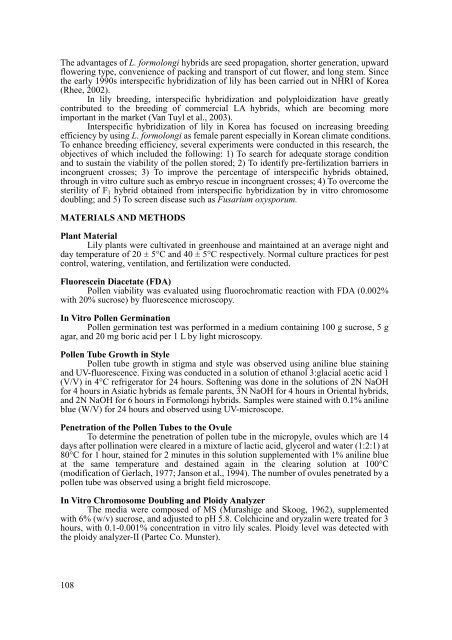Improvement of Breeding Efficiency for Interspecific Hybridization of ...
Improvement of Breeding Efficiency for Interspecific Hybridization of ...
Improvement of Breeding Efficiency for Interspecific Hybridization of ...
Create successful ePaper yourself
Turn your PDF publications into a flip-book with our unique Google optimized e-Paper software.
The advantages <strong>of</strong> L. <strong>for</strong>molongi hybrids are seed propagation, shorter generation, upward<br />
flowering type, convenience <strong>of</strong> packing and transport <strong>of</strong> cut flower, and long stem. Since<br />
the early 1990s interspecific hybridization <strong>of</strong> lily has been carried out in NHRI <strong>of</strong> Korea<br />
(Rhee, 2002).<br />
In lily breeding, interspecific hybridization and polyploidization have greatly<br />
contributed to the breeding <strong>of</strong> commercial LA hybrids, which are becoming more<br />
important in the market (Van Tuyl et al., 2003).<br />
<strong>Interspecific</strong> hybridization <strong>of</strong> lily in Korea has focused on increasing breeding<br />
efficiency by using L. <strong>for</strong>molongi as female parent especially in Korean climate conditions.<br />
To enhance breeding efficiency, several experiments were conducted in this research, the<br />
objectives <strong>of</strong> which included the following: 1) To search <strong>for</strong> adequate storage condition<br />
and to sustain the viability <strong>of</strong> the pollen stored; 2) To identify pre-fertilization barriers in<br />
incongruent crosses; 3) To improve the percentage <strong>of</strong> interspecific hybrids obtained,<br />
through in vitro culture such as embryo rescue in incongruent crosses; 4) To overcome the<br />
sterility <strong>of</strong> F 1 hybrid obtained from interspecific hybridization by in vitro chromosome<br />
doubling; and 5) To screen disease such as Fusarium oxysporum.<br />
MATERIALS AND METHODS<br />
Plant Material<br />
Lily plants were cultivated in greenhouse and maintained at an average night and<br />
day temperature <strong>of</strong> 20 ± 5°C and 40 ± 5°C respectively. Normal culture practices <strong>for</strong> pest<br />
control, watering, ventilation, and fertilization were conducted.<br />
Fluorescein Diacetate (FDA)<br />
Pollen viability was evaluated using fluorochromatic reaction with FDA (0.002%<br />
with 20% sucrose) by fluorescence microscopy.<br />
In Vitro Pollen Germination<br />
Pollen germination test was per<strong>for</strong>med in a medium containing 100 g sucrose, 5 g<br />
agar, and 20 mg boric acid per 1 L by light microscopy.<br />
Pollen Tube Growth in Style<br />
Pollen tube growth in stigma and style was observed using aniline blue staining<br />
and UV-fluorescence. Fixing was conducted in a solution <strong>of</strong> ethanol 3:glacial acetic acid 1<br />
(V/V) in 4°C refrigerator <strong>for</strong> 24 hours. S<strong>of</strong>tening was done in the solutions <strong>of</strong> 2N NaOH<br />
<strong>for</strong> 4 hours in Asiatic hybrids as female parents, 3N NaOH <strong>for</strong> 4 hours in Oriental hybrids,<br />
and 2N NaOH <strong>for</strong> 6 hours in Formolongi hybrids. Samples were stained with 0.1% aniline<br />
blue (W/V) <strong>for</strong> 24 hours and observed using UV-microscope.<br />
Penetration <strong>of</strong> the Pollen Tubes to the Ovule<br />
To determine the penetration <strong>of</strong> pollen tube in the micropyle, ovules which are 14<br />
days after pollination were cleared in a mixture <strong>of</strong> lactic acid, glycerol and water (1:2:1) at<br />
80°C <strong>for</strong> 1 hour, stained <strong>for</strong> 2 minutes in this solution supplemented with 1% aniline blue<br />
at the same temperature and destained again in the clearing solution at 100°C<br />
(modification <strong>of</strong> Gerlach, 1977; Janson et al., 1994). The number <strong>of</strong> ovules penetrated by a<br />
pollen tube was observed using a bright field microscope.<br />
In Vitro Chromosome Doubling and Ploidy Analyzer<br />
The media were composed <strong>of</strong> MS (Murashige and Skoog, 1962), supplemented<br />
with 6% (w/v) sucrose, and adjusted to pH 5.8. Colchicine and oryzalin were treated <strong>for</strong> 3<br />
hours, with 0.1-0.001% concentration in vitro lily scales. Ploidy level was detected with<br />
the ploidy analyzer-II (Partec Co. Munster).<br />
108














